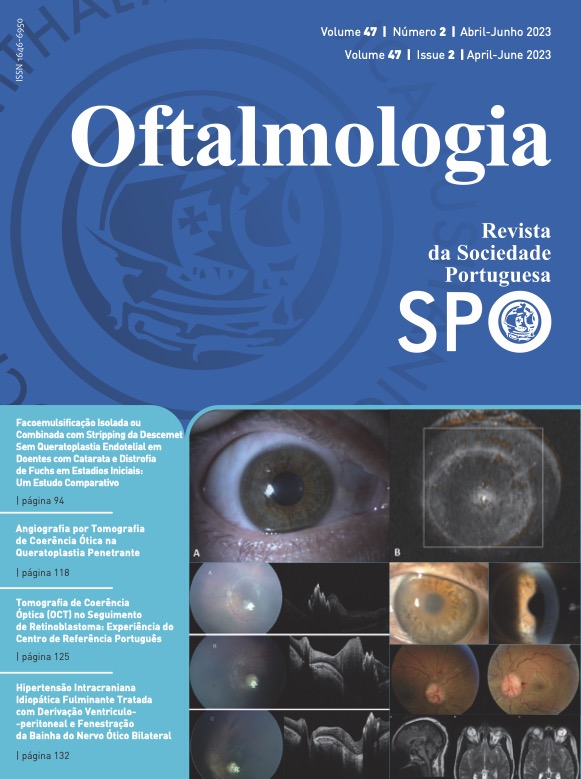Propriedades Biomecânicas e Pressão Intraocular a Longo Prazo em Doentes com Queratocone Submetidos a Queratoplastia Penetrante e Queratoplastia Lamelar Anterior Profunda
DOI:
https://doi.org/10.48560/rspo.25903Palavras-chave:
Córnea/fisiologia, Fenómenos Biomecânicos, Pressão Introcular, Queratoconus, Queratoplastia PenetranteResumo
INTRODUÇÃO: O nosso objectivo foi comparar as propriedades biomecânicas e a pressão intraocular a longo prazo entre olhos tratados com queratoplastia penetrante (PKP) e queratoplas- tia lamelar anterior profunda (DALK) em doentes com queratocone e doentes saudáveis.
MÉTODOS: Estudo retrospetivo observacional caso-controlo com avaliação biomecânica da córnea por imagem de Scheimpflug de alta velocidade durante tonometria de não contacto (Corvis ST, OCULUS®). A pressão intraocular (PIO) foi avaliada com: tonómetro de aplanação de Goldmann; tonómetro de não contacto, corrigido biomecanicamente pelo Corvis ST e corrigido pelo Pentacam (correção de Ehlers, Shah, Dresden e Spoerl).
RESULTADOS: O estudo incluiu 104 olhos: 18 olhos tratados com PKP, 34 olhos tratados com DALK e 52 olhos saudáveis. A média de idade na avaliação biomecânica foi semelhante entre olhos tratados e olhos saudáveis (p = 0,980). O tempo médio de acompanhamento foi semelhante entre os olhos tratados com PKP e DALK (p = 0,273). Olhos tratados com PKP e DALK mostraram um comportamento significativamente menos rígido nos parâmetros corneanos biomecânicos de 1a (19/28 e 21/28, respetivamente) e 2a (8/11 e 9/11, respetivamente) geração em comparação com o grupo de controlo. Não houve diferença nos parâmetros biomecânicos da córnea de 1a e 2a geração entre os olhos tratados com PKP e DALK e entre as técnicas de “big bubble” e “dissecção manual” no grupo DALK. Quando analisada a PIO pós-operatória medida por métodos diferentes, os va- lores médios foram semelhantes entre os olhos tratados com PKP e DALK.
CONCLUSÃO: Nenhuma das duas técnicas de queratoplastia conseguiu a restauração com- pleta da biomecânica da córnea. Ao comparar diretamente os olhos tratados com PKP e DALK, não houve diferenças significativas no comportamento biomecânico. As médias das PIOs pós-operatórias medidas por métodos diferentes foram semelhantes entre os olhos tratados com PKP e DALK.
Downloads
Referências
Keratoconus [Internet]. NORD (National Organization for Rare Disorders). [cited 2021 Jun 7]. Available from: https://rarediseases.org/rare-diseases/keratoconus/
Rabinowitz YS. Keratoconus. Surv Ophthalmol. 1998 Feb;42(4):297–319.
Parker JS, van Dijk K, Melles GRJ. Treatment options for advanced keratoconus: A review. Surv Ophthalmol. 2015 Oct;60(5):459–80.
Arnalich-Montiel F, Alió del Barrio JL, Alió JL. Corneal surgery in keratoconus: which type, which technique, which outcomes? Eye and Vision. 2016 Jan 18;3(1):2.
Reinhart WJ, Musch DC, Jacobs DS, Lee WB, Kaufman SC, Shtein RM. Deep anterior lamellar keratoplasty as an alternative to penetrating keratoplasty a report by the american academy of ophthalmology. Ophthalmology. 2011 Jan;118(1):209–18.
Esporcatte LPG, Salomão MQ, Lopes BT, Vinciguerra P, Vinciguerra R, Roberts C, et al. Biomechanical diagnostics of the cornea. Eye and Vision. 2020 Feb 5;7(1):9.
Schulze-Bonsel K, Feltgen N, Burau H, Hansen L, Bach M. Visual Acuities “Hand Motion” and “Counting Fingers” Can Be Quantified with the Freiburg Visual Acuity Test. Invest Ophthalmol Vis Sci. 2006 Mar 1;47(3):1236–40.
Baptista PM, Marta AA, Marques JH, Abreu AC, Monteiro S, Menéres P, et al. The Role of Corneal Biomechanics in the Assessment of Ectasia Susceptibility Before Laser Vision Correction. Clin Ophthalmol. 2021;15:745–58.
Belin MW, Duncan JK. Keratoconus: The ABCD Grading System. Klin Monbl Augenheilkd. 2016 Jun;233(6):701–7.
Brookes NH, Loh I-P, Clover GM, Poole CA, Sherwin T. Involvement of corneal nerves in the progression of keratoconus. Exp Eye Res. 2003 Oct;77(4):515–24.
Meyer JJ, McGhee CNJ. Incidence, severity and outcomes of traumatic wound dehiscence following penetrating and deep anterior lamellar keratoplasty. Br J Ophthalmol. 2016 Oct;100(10):1412–5.
Hindman HB, McCally RL, Kim A, D’Anna SE, Eberhart CG, Jun AS. Evaluation of the effects of circular Descemet’s membrane incision on the biomechanical, topographic and optical properties of rabbit corneas. Clin Exp Ophthalmol. 2011 Oct;39(7):691–9.
John T, Taylor DA, Shimmyo M, Siskowski BE. Corneal hysteresis following descemetorhexis with endokeratoplasty: early results. Ann Ophthalmol (Skokie). 2007;39(1):9–14.
Hosny M, Hassaballa MAM, Shalaby A. Changes in corneal biomechanics following different keratoplasty techniques. Clin Ophthalmol. 2011;5:767–70.
Ma J, Wang Y, Wei P, Jhanji V. Biomechanics and structure of the cornea: implications and association with corneal disorders. Surv Ophthalmol. 2018 Dec;63(6):851–61.
Ziaei M, Vellara HR, Gokul A, Ali NQ, McGhee CNJ, Patel DV. Comparison of corneal biomechanical properties following penetrating keratoplasty and deep anterior lamellar keratoplasty for keratoconus. Clin Exp Ophthalmol. 2020 Mar;48(2):174–82.
Jiang M-S, Zhu J-Y, Li X, Zhang N-N, Zhang X-D. Corneal Biomechanical Properties After Penetrating Keratoplasty or Deep Anterior Lamellar Keratoplasty Using the Ocular Response Analyzer: A Meta-Analysis. Cornea. 2017 Mar;36(3):310–6.
Baradaran-Rafii A, Eslani M, Sadoughi M-M, Esfandiari H, Karimian F. Anwar versus Melles deep anterior lamellar keratoplasty for keratoconus: a prospective randomized clinical trial. Ophthalmology. 2013 Feb;120(2):252–9.
Akdemir MO, Acar BT, Acar S. Biomechanics in DALK: Big bubble vs manual lamellar dissection. Arq Bras Oftalmol. 2020 Apr;83(2):87–91.
Nawaz S, Sofi IA, Maharana PK, Shaveta S. Comparison of biomechanical properties between post penetrating keratoplasty and deep anterior lamellar keratoplasty in keratoconus patients using ocular response analyser. International Journal of Medical Research and Review. 2015 Oct 31;3(9):939–46.
Downloads
Publicado
Como Citar
Edição
Secção
Licença
Direitos de Autor (c) 2023 Revista Sociedade Portuguesa de Oftalmologia

Este trabalho encontra-se publicado com a Creative Commons Atribuição-NãoComercial 4.0.
Não se esqueça de fazer o download do ficheiro da Declaração de Responsabilidade Autoral e Autorização para Publicação e de Conflito de Interesses
O artigo apenas poderá ser submetido com esse dois documentos.
Para obter o ficheiro da Declaração de Responsabilidade Autoral, clique aqui
Para obter o ficheiro de Conflito de Interesses, clique aqui





